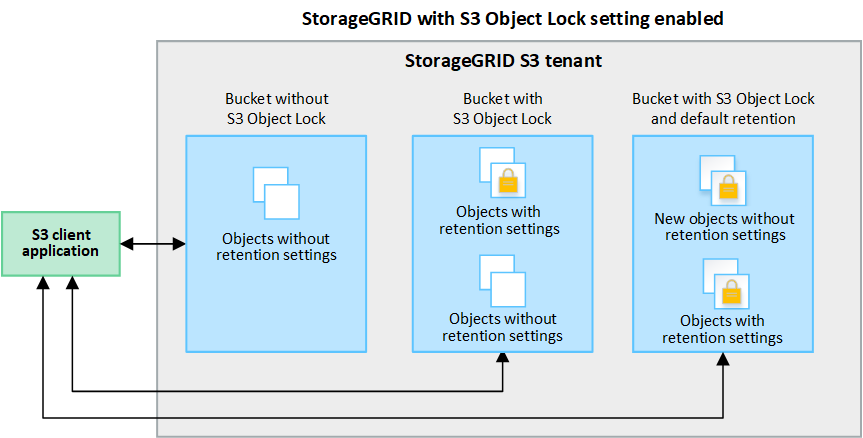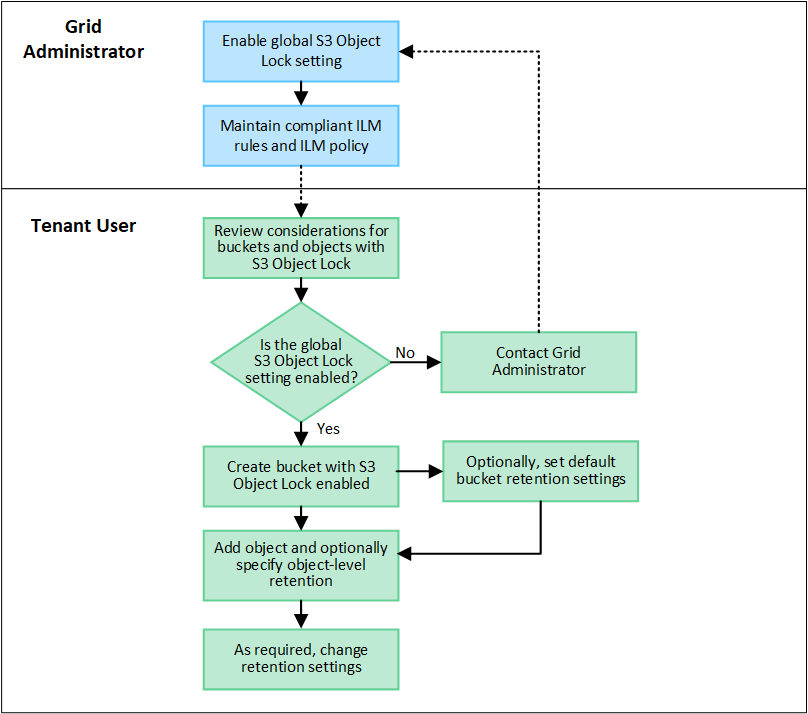Use S3 Object Lock to retain objects
 Suggest changes
Suggest changes


You can use S3 Object Lock if buckets and objects must comply with regulatory requirements for retention.
What is S3 Object Lock?
The StorageGRID S3 Object Lock feature is an object-protection solution that is equivalent to S3 Object Lock in Amazon Simple Storage Service (Amazon S3).
As shown in the figure, when the global S3 Object Lock setting is enabled for a StorageGRID system, an S3 tenant account can create buckets with or without S3 Object Lock enabled. If a bucket has S3 Object Lock enabled, bucket versioning is required and is enabled automatically.
If a bucket has S3 Object Lock enabled, S3 client applications can optionally specify retention settings for any object version saved to that bucket.
In addition, a bucket that has S3 Object Lock enabled can optionally have a default retention mode and retention period. The default settings apply only to objects that are added to the bucket without their own retention settings.

Retention modes
The StorageGRID S3 Object Lock feature supports two retention modes to apply different levels of protection to objects. These modes are equivalent to the Amazon S3 retention modes.
-
In compliance mode:
-
The object can't be deleted until its retain-until-date is reached.
-
The object's retain-until-date can be increased, but it can't be decreased.
-
The object's retain-until-date can't be removed until that date is reached.
-
-
In governance mode:
-
Users with special permission can use a bypass header in requests to modify certain retention settings.
-
These users can delete an object version before its retain-until-date is reached.
-
These users can increase, decrease, or remove an object's retain-until-date.
-
Retention settings for object versions
If a bucket is created with S3 Object Lock enabled, users can use the S3 client application to optionally specify the following retention settings for each object that is added to the bucket:
-
Retention mode: Either compliance or governance.
-
Retain-until-date: If an object version's retain-until-date is in the future, the object can be retrieved, but it can't be deleted.
-
Legal hold: Applying a legal hold to an object version immediately locks that object. For example, you might need to put a legal hold on an object that is related to an investigation or legal dispute. A legal hold has no expiration date, but remains in place until it is explicitly removed. Legal holds are independent of the retain-until-date.
If an object is under a legal hold, no one can delete the object, regardless of its retention mode. For details on the object settings, see Use S3 REST API to configure S3 Object Lock.
Default retention setting for buckets
If a bucket is created with S3 Object Lock enabled, users can optionally specify the following default settings for the bucket:
-
Default retention mode: Either compliance or governance.
-
Default retention period: How long new object versions added to this bucket should be retained, starting from the day they are added.
The default bucket settings apply only to new objects that don't have their own retention settings. Existing bucket objects aren't affected when you add or change these default settings.
S3 Object Lock workflow
The workflow diagram shows the high-level steps for using the S3 Object Lock feature in StorageGRID.
Before you can create buckets with S3 Object Lock enabled, the grid administrator must enable the global S3 Object Lock setting for the entire StorageGRID system. The grid administrator must also ensure that the information lifecycle management (ILM) policy is “compliant”; it must meet the requirements of buckets with S3 Object Lock enabled. For details, contact your grid administrator or see the instructions for manage objects with S3 Object Lock.
After the global S3 Object Lock setting has been enabled, you can create buckets with S3 Object Lock enabled and optionally specify default retention settings for each bucket. In addition, you can use the S3 client application to optionally specify retention settings for each object version.

Requirements for buckets with S3 Object Lock enabled
-
If the global S3 Object Lock setting is enabled for the StorageGRID system, you can use the Tenant Manager, the Tenant Management API, or the S3 REST API to create buckets with S3 Object Lock enabled.
-
If you plan to use S3 Object Lock, you must enable S3 Object Lock when you create the bucket. You can't enable S3 Object Lock for an existing bucket.
-
When S3 Object Lock is enabled for a bucket, StorageGRID automatically enables versioning for that bucket. You can't disable S3 Object Lock or suspend versioning for the bucket.
-
Optionally, you can specify a default retention mode and retention period for each bucket using the Tenant Manager, the Tenant Management API, or the S3 REST API. The bucket's default retention settings apply only to new objects added to the bucket that don't have their own retention settings. You can override these default settings by specifying a retention mode and retain-until-date for each object version when it is uploaded.
-
Bucket lifecycle configuration is supported for buckets with S3 Object Lock enabled.
-
CloudMirror replication is not supported for buckets with S3 Object Lock enabled.
Requirements for objects in buckets with S3 Object Lock enabled
-
To protect an object version, you can specify default retention settings for the bucket, or you can specify retention settings for each object version. Object-level retention settings can be specified using the S3 client application or the S3 REST API.
-
Retention settings apply to individual object versions. An object version can have both a retain-until-date and a legal hold setting, one but not the other, or neither. Specifying a retain-until-date or a legal hold setting for an object protects only the version specified in the request. You can create new versions of the object, while the previous version of the object remains locked.
Lifecycle of objects in buckets with S3 Object Lock enabled
Each object that is saved in a bucket with S3 Object Lock enabled goes through these stages:
-
Object ingest
When an object version is added to bucket that has S3 Object Lock enabled, retention settings are applied as follows:
-
If retention settings are specified for the object, the object-level settings are applied. Any default bucket settings are ignored.
-
If no retention settings are specified for the object, the default bucket settings are applied, if they exist.
-
If no retention settings are specified for the object or the bucket, the object is not protected by S3 Object Lock.
If retention settings are applied, both the object and any S3 user-defined metadata are protected.
-
-
Object retention and deletion
Multiple copies of each protected object are stored by StorageGRID for the specified retention period. The exact number and type of object copies and the storage locations are determined by the compliant rules in the active ILM policy. Whether a protected object can be deleted before its retain-until-date is reached depends on its retention mode.
-
If an object is under a legal hold, no one can delete the object, regardless of its retention mode.
-
Can I still manage legacy Compliant buckets?
The S3 Object Lock feature replaces the Compliance feature that was available in previous StorageGRID versions. If you created compliant buckets using a previous version of StorageGRID, you can continue to manage the settings of these buckets; however, you can no longer create new compliant buckets. For instructions, see NetApp Knowledge Base: How to manage legacy Compliant buckets in StorageGRID 11.5.



